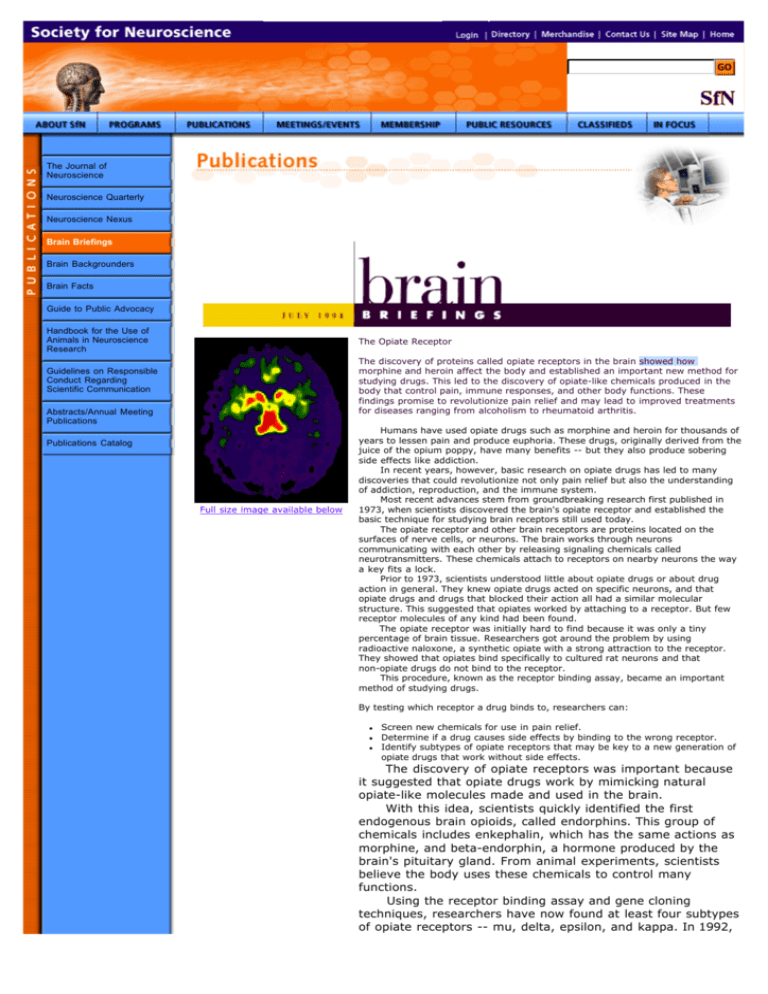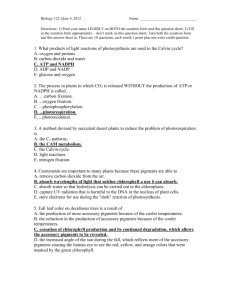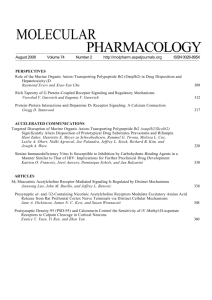The Opiate Receptor
advertisement

The Journal of Neuroscience Neuroscience Quarterly Neuroscience Nexus Brain Briefings Brain Backgrounders Brain Facts Guide to Public Advocacy Handbook for the Use of Animals in Neuroscience Research The Opiate Receptor The discovery of proteins called opiate receptors in the brain showed how morphine and heroin affect the body and established an important new method for studying drugs. This led to the discovery of opiate-like chemicals produced in the body that control pain, immune responses, and other body functions. These findings promise to revolutionize pain relief and may lead to improved treatments for diseases ranging from alcoholism to rheumatoid arthritis. Guidelines on Responsible Conduct Regarding Scientific Communication Abstracts/Annual Meeting Publications Publications Catalog Full size image available below Humans have used opiate drugs such as morphine and heroin for thousands of years to lessen pain and produce euphoria. These drugs, originally derived from the juice of the opium poppy, have many benefits -- but they also produce sobering side effects like addiction. In recent years, however, basic research on opiate drugs has led to many discoveries that could revolutionize not only pain relief but also the understanding of addiction, reproduction, and the immune system. Most recent advances stem from groundbreaking research first published in 1973, when scientists discovered the brain's opiate receptor and established the basic technique for studying brain receptors still used today. The opiate receptor and other brain receptors are proteins located on the surfaces of nerve cells, or neurons. The brain works through neurons communicating with each other by releasing signaling chemicals called neurotransmitters. These chemicals attach to receptors on nearby neurons the way a key fits a lock. Prior to 1973, scientists understood little about opiate drugs or about drug action in general. They knew opiate drugs acted on specific neurons, and that opiate drugs and drugs that blocked their action all had a similar molecular structure. This suggested that opiates worked by attaching to a receptor. But few receptor molecules of any kind had been found. The opiate receptor was initially hard to find because it was only a tiny percentage of brain tissue. Researchers got around the problem by using radioactive naloxone, a synthetic opiate with a strong attraction to the receptor. They showed that opiates bind specifically to cultured rat neurons and that non-opiate drugs do not bind to the receptor. This procedure, known as the receptor binding assay, became an important method of studying drugs. By testing which receptor a drug binds to, researchers can: Screen new chemicals for use in pain relief. Determine if a drug causes side effects by binding to the wrong receptor. Identify subtypes of opiate receptors that may be key to a new generation of opiate drugs that work without side effects. The discovery of opiate receptors was important because it suggested that opiate drugs work by mimicking natural opiate-like molecules made and used in the brain. With this idea, scientists quickly identified the first endogenous brain opioids, called endorphins. This group of chemicals includes enkephalin, which has the same actions as morphine, and beta-endorphin, a hormone produced by the brain's pituitary gland. From animal experiments, scientists believe the body uses these chemicals to control many functions. Using the receptor binding assay and gene cloning techniques, researchers have now found at least four subtypes of opiate receptors -- mu, delta, epsilon, and kappa. In 1992, the delta receptor was first to be cloned and others soon followed. Cloning the receptors has helped scientists develop gene probes to locate the receptors in individual cells and other models for receptor subtypes that can reveal how new drugs work. Scientists also have found that certain brain opioids act more on some receptor subtypes than others. This may lead to the development of new pain-relieving drugs that do not cause depressed breathing rate, addiction, or other side effects. Researchers believe that opioid receptors may be important for the release of luteinizing hormone, an important reproductive peptide, and regulation of the immune system. This knowledge may help scientists develop new treatments for problems ranging from delayed puberty to rheumatoid arthritis. Naltrexone, an opioid blocker, is now in clinical trials as a treatment for alcoholism. Scientists can map brain structures that contain opiate receptors and are responsible for opiate drug effects on the body. This positron emission tomography (PET) scan of mu opiate receptors in the human brain shows the highest concentrations in the thalamus (red) which is involved in pain; intermediate concentrations in the cerebral cortex (green) and basal ganglia (yellow and orange) which plays an important role in movement and emotions; and low levels in the visual cortex (violet). PET scan by J. James Frost, M.D., Ph.D, Johns Hopkins Hospital For more information please contact Leah Ariniello, Science Writer, Society for Neuroscience, 11 Dupont Circle, NW, Suite 500, Washington DC 20036. About SfN | Programs | Publications | Meetings/Events | Membership Public Resources | Classifieds | In Focus | Directory | Merchandise | Contact Us | Site Map | Home Contact Us | SfN Disclaimer Copyright © 2003 Society for Neuroscience







